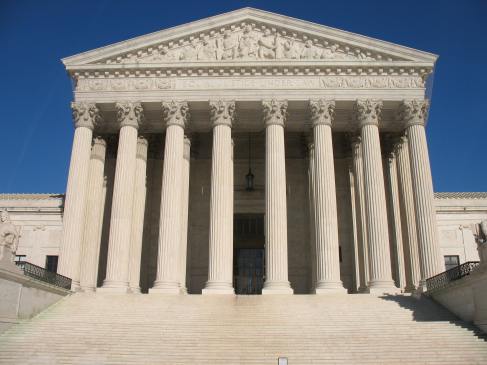
Today, the Supreme Court heard arguments on Hollingsworth v. Perry, which will decide the constitutionality of California’s Proposition 8, which banned same-sex marriage in the state not long after it had been legalized by a court ruling. Here are a few of my favorite moments from the transcript, denoted in italics. My comments are in brackets.
ORAL ARGUMENT OF CHARLES J COOPER, ON BEHALF OF THE PETITIONERS
[Cooper is arguing on behalf of the proponents of Prop 8.]
MR. COOPER: I think, Justice Sotomayor, you’re probing into whether or not sexual orientation ought to be viewed as a quasi-suspect or suspect class, and our position is that it does not qualify under this Court’s standard and - and traditional tests for identifying suspectedness. The — the class itself is — is quite amorphous. It defies consistent definition as — as the Plaintiffs’ own experts were — were quite vivid on. It — it does not — it — it does not qualify as an accident of birth, immutability in that — in that sense.
[This bit marks the beginning of a long discussion that the court will have over whether laws that treat people differently based on sexual orientation should be subject to heightened scrutiny. Laws that do this based on sex or race are subject to strict scrutiny, whereas the Supreme Court decided in Romer v. Evans that sexual orientation should be subject to the rational basis test, or the lowest level of scrutiny. The Petitioners are arguing that sexual orientation is behavioral only and therefore should not receive the same privileged classification as sex or race, while the Respondents are arguing that LGBT people constitute a tangible identity, and Prop 8 should receive heightened scrutiny.
Heightened scrutiny makes it much more likely that the law in question will be struck down. In addition, subjecting Prop 8 to heightened scrutiny will serve to legitimize LGBT identity in the eyes of those who still view it as unnatural.]
JUSTICE SCALIA: I suppose we could have a questionnaire at the marriage desk when people come in to get the marriage — you know, Are you fertile or are you not fertile?
(Laughter.)
JUSTICE SCALIA: I suspect this Court would hold that to be an unconstitutional invasion of privacy, don’t you think?
[Justice Scalia’s question was part of a line of thought concerning the procreative utility of heterosexual identity and Mr. Cooper’s argument that marriage shouldn’t extend to those who can’t procreate, namely, gay couples. Justice Kagan had asked whether elderly or infertile couples should also be denied marriage licenses.]
ORAL ARGUMENT OF THEODORE B. OLSON, ON BEHALF OF THE RESPONDENTS
[Olson is arguing on behalf of opponents of Prop 8.]
CHIEF JUSTICE ROBERTS: I’m not sure, counsel, that it makes — I’m not sure that it’s right to view this as excluding a particular group. When the institution of marriage developed historically, people didn’t get around and say let’s have this institution, but let’s keep out homosexuals. The institution developed to serve purposes that, by their nature, didn’t include homosexual couples.
[Chief Justice Roberts returns to the question of whether LGBT people constitute a tangible “group.” This bit was a sign from Roberts, considered a swing vote, that he felt the government had an interest in excluding gay couples from the institution of marriage. Should the Court decide that laws dividing people based on sexual orientation are not subject to heightened scrutiny, this could be the “rational basis” that the Court needs to see in order to uphold Prop 8.]
MR. OLSON: But what I have before you now, the case that’s before you today, is whether or not California can take a class of individuals based upon their characteristics, their distinguishing characteristics, remove from them the right of privacy, liberty, association, spirituality, and identity that -that marriage gives them. It — it is — it is not an answer to say procreation or anything of that nature, because procreation is not a part of the right to get married.
JUSTICE KENNEDY: That’s really — that’s a broad argument that you — that’s in this case if the Court wants to reach it. The rationale of the Ninth Circuit was much more narrow. It basically said that California, which has been more generous, more open to protecting same-sex couples than almost any State in the Union, just didn’t go far enough, and it’s being penalized for not going far enough.
[Mr. Olson pushes back on Chief Justice Robert’s previous point. Justice Kennedy, whom I believe to be the most likely defection among the Court’s five conservative justices, expresses hesitation about issuing a sweeping ruling and support for a strike-down of Prop 8 on narrow grounds that would restrict same-sex marriage rights to the state of California. One of my worries while reading the transcript was that Mr. Olson did not spend enough time defending the merits of a narrow ruling, which the Justices need to understand if they are to overturn Prop 8 on any grounds.]
JUSTICE SOTOMAYOR: Is there any way to decide this case in a principled manner that is limited to California only?
MR. OLSON: Yes, the Ninth Circuit did that. You can decide the standing case that limits it to the decision of the district court here. You could decide it as the Ninth Circuit did -
JUSTICE KENNEDY: The problem — the problem with the case is that you’re really asking, particularly because of the sociological evidence you cite, for us to go into uncharted waters, and you can play with that metaphor, there’s a wonderful destination, it is a cliff. Whatever that was.
(Laughter.)
JUSTICE KENNEDY: But you’re — you’re doing so in a — in a case where the opinion is very narrow. Basically that once the State goes halfway, it has to go all the way or 70 percent of the way, and you’re doing so in a case where there’s a substantial question on -on standing. I just wonder if — if the case was properly granted.
[Again with the all-or-nothing duality Mr. Olson seems to be setting up. It’s doubtful that the Court will issue a sweeping ruling, but a narrow victory for marriage equality, restricted to the state of California, is better than none. I worry that the Court (more specifically, Justice Kennedy), finding insufficient cause for issuing a sweeping decision, will vote to uphold Prop 8.]
MR. OLSON: I — I respectfully submit that we’ve under — we’ve learned to understand more about sexual orientation and what it means to individuals. I guess the — the language that Justice Ginsburg used at the closing of the VMI case is an important thing, it resonates with me, “A prime part of the history of our Constitution is the story of the extension of constitutional rights to people once ignored or excluded.”
CHIEF JUSTICE ROBERTS: Thank you, counsel.
[Nice closing. Mr. Olson has style.]
ORAL ARGUMENT OF DONALD B. VERRILLI, JR., FOR THE UNITED STATES, AS AMICUS CURIAE, SUPPORTING THE RESPONDENTS
[Verrilli is arguing against Prop 8 on behalf of the Obama Administration.]
GENERAL VERRILLI: California did not through Proposition 8 do what my friend Mr. Cooper said and push a pause button. They pushed a delete button. This is a permanent ban. It’s in the Constitution. It’s supposed to take this issue out from the legislative process.
[General Verrilli pushes back on the argument that the states shouldn’t do “social experiments” by legalizing same-sex marriage.]
CHIEF JUSTICE ROBERTS: I don’t want to — I want you to get back to Justice Alito’s other points, but is it the position of the United States that same-sex marriage is not required throughout the country?
GENERAL VERRILLI: We are not — we are not taking the position that it is required throughout the country. We think that that ought to be left open for a future adjudication in other States that don’t have the situation California has.
JUSTICE SCALIA: So your — your position is only if a State allows civil unions does it become unconstitutional to forbid same-sex marriage, right?
GENERAL VERRILLI: I — I see my red light is on.
CHIEF JUSTICE ROBERTS: Well, you can go on.
GENERAL VERRILLI: Thank you. Our position is — I would just take out a red pen and take the word “only” out of that sentence. When that is true, then the Equal Protection Clause forbids the exclusion of same-sex marriage, and it’s an open question otherwise.
[The Obama Administration’s position on Hollingsworth v. Perry is that if a state allows civil unions but not same-sex marriages, it violates the Equal Protection clause of the Fourteenth Amendment. Therefore, Verrilli is arguing that the Court should issue a wider ruling and strike down bans on same-sex marriage in states that have civil unions. This is a valid (albeit flawed) argument from a constitutional standpoint, but from a practical standpoint it might discourage states from legalizing domestic partnerships or civil unions, since they might feel that the Court’s ruling would force them to go all the way and legalize same-sex marriage. I’m a little confused about the Obama Administration’s motivations here.]
GENERAL VERRILLI: Well, we — we think that, as I started my argument, Your Honor, that all the warning flags for exacting equal protection scrutiny are present here. This is a group that has suffered a history of terrible discrimination. The Petitioners don’t deny it.
[General Verrilli brings home the debate on what level of scrutiny to apply to Prop 8.]

















































